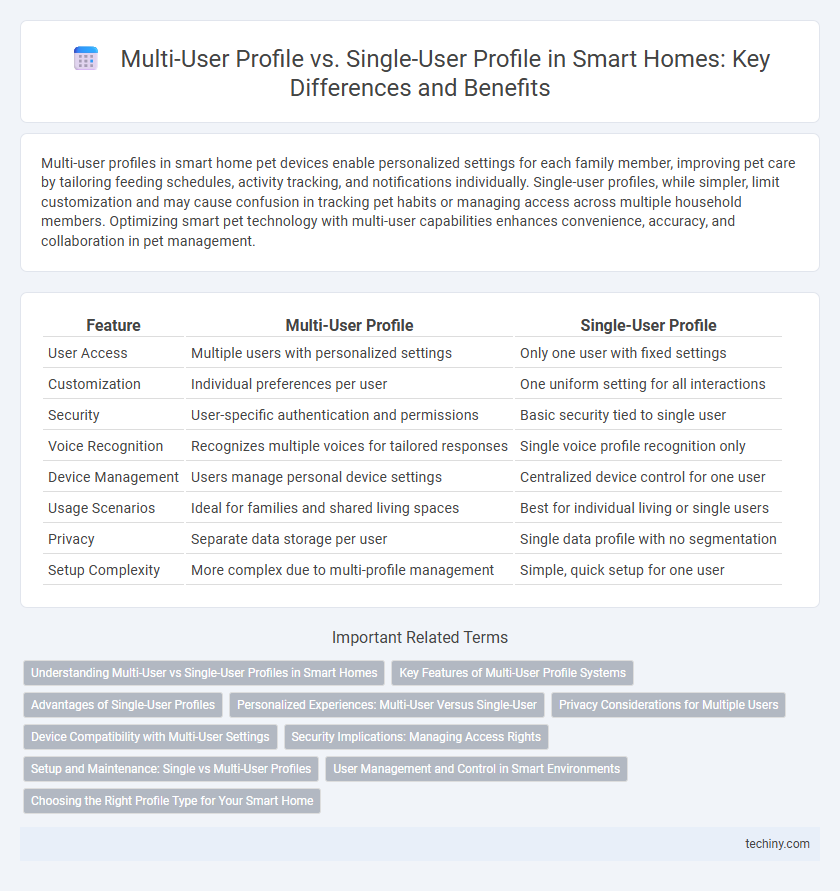Multi-user profiles in smart home pet devices enable personalized settings for each family member, improving pet care by tailoring feeding schedules, activity tracking, and notifications individually. Single-user profiles, while simpler, limit customization and may cause confusion in tracking pet habits or managing access across multiple household members. Optimizing smart pet technology with multi-user capabilities enhances convenience, accuracy, and collaboration in pet management.
Table of Comparison
| Feature | Multi-User Profile | Single-User Profile |
|---|---|---|
| User Access | Multiple users with personalized settings | Only one user with fixed settings |
| Customization | Individual preferences per user | One uniform setting for all interactions |
| Security | User-specific authentication and permissions | Basic security tied to single user |
| Voice Recognition | Recognizes multiple voices for tailored responses | Single voice profile recognition only |
| Device Management | Users manage personal device settings | Centralized device control for one user |
| Usage Scenarios | Ideal for families and shared living spaces | Best for individual living or single users |
| Privacy | Separate data storage per user | Single data profile with no segmentation |
| Setup Complexity | More complex due to multi-profile management | Simple, quick setup for one user |
Understanding Multi-User vs Single-User Profiles in Smart Homes
Multi-user profiles in smart homes enable personalized settings, preferences, and access controls for each resident, enhancing convenience and security by tailoring device interactions to individual needs. Single-user profiles centralize control but lack customization, making them suitable for simpler household setups or users preferring unified management. Understanding these distinctions is crucial for optimizing smart home systems to balance personalization, privacy, and ease of use.
Key Features of Multi-User Profile Systems
Multi-user profile systems in smart homes enable personalized settings for each resident, including tailored lighting, climate control, and entertainment preferences, enhancing comfort and convenience. These systems support individual access permissions, ensuring security by restricting device control based on user roles. Advanced activity recognition and user-specific automation further optimize energy efficiency and user experience across shared household environments.
Advantages of Single-User Profiles
Single-user profiles in smart home systems offer streamlined customization and personalized settings tailored to individual preferences, enhancing user experience. They reduce complexity by limiting access to one user's data and controls, improving security and minimizing the risk of unauthorized changes. This focused approach ensures efficient device management, faster response times, and straightforward troubleshooting within the smart home ecosystem.
Personalized Experiences: Multi-User Versus Single-User
Multi-user profiles in smart homes enable personalized experiences by tailoring settings, preferences, and device interactions to each individual's habits and routines, enhancing comfort and convenience. Single-user profiles offer basic customization but often lack the depth of personalization, leading to generalized automation that may not suit all household members. Optimizing smart home systems with multi-user profiles improves user satisfaction through adaptive lighting, temperature control, and personalized content recommendations for each resident.
Privacy Considerations for Multiple Users
Multi-user profiles in smart home systems enhance privacy by allowing individualized access controls, ensuring that personal data and preferences remain isolated for each occupant. Single-user profiles increase the risk of unauthorized data access and unintended sharing of sensitive information due to the lack of personalized security settings. Implementing multi-user profiles safeguards privacy by enabling tailored permissions and activity logs specific to each user, reducing potential breaches and improving overall data management.
Device Compatibility with Multi-User Settings
Multi-user profiles significantly enhance device compatibility by allowing personalized settings and preferences for each user on a single smart home system, enabling seamless integration across various devices such as smart speakers, thermostats, and security cameras. Unlike single-user profiles that limit access to one set of configurations, multi-user settings support simultaneous voice recognition and personalized routines, improving user experience and efficiency in shared environments. Devices from leading brands like Amazon Alexa, Google Nest, and Apple HomeKit are increasingly optimized to handle multiple user profiles, ensuring better customization and smarter automation tailored to individual household members.
Security Implications: Managing Access Rights
Multi-user profiles in smart homes enable granular access control, allowing homeowners to assign customized permissions to each user, thereby enhancing security by limiting unauthorized device usage. Single-user profiles centralize control but increase risk, as a single compromised account can grant access to the entire system. Effective management of access rights in multi-user setups reduces potential vulnerabilities and supports audit trails for better monitoring of device interactions.
Setup and Maintenance: Single vs Multi-User Profiles
Single-user profiles in smart home systems offer streamlined setup and minimal maintenance, as configurations and preferences are customized for one individual, reducing complexity. Multi-user profiles require more intricate initial setup to accommodate diverse preferences, permissions, and access controls for each user, resulting in increased ongoing management to synchronize changes and maintain security. Optimizing smart home devices for multi-user scenarios enhances personalized experiences but demands robust profile management tools to simplify administrative tasks.
User Management and Control in Smart Environments
Multi-user profiles in smart home systems enable personalized settings and access control for each resident, enhancing security and customization compared to single-user profiles. These profiles allow administrators to assign permission levels, restricting device access based on user roles, which is crucial for managing privacy in shared environments. Efficient user management in multi-user setups supports seamless interaction across various connected devices, improving overall smart home control and user experience.
Choosing the Right Profile Type for Your Smart Home
Selecting the ideal profile type for your smart home depends on the number of users and customization needs; multi-user profiles offer personalized settings, individual preferences, and access control for each household member, enhancing convenience and security. Single-user profiles simplify management with a unified control interface but may limit personalization and device access restrictions. Evaluate household size, privacy concerns, and desired level of automation to determine whether multi-user or single-user smart home profiles best align with your lifestyle.
Multi-User Profile vs Single-User Profile Infographic

 techiny.com
techiny.com